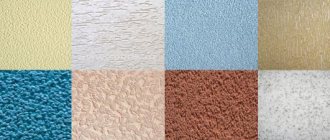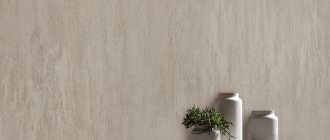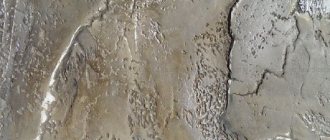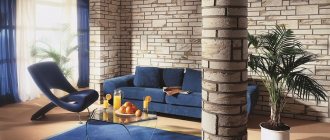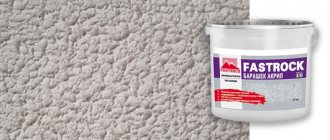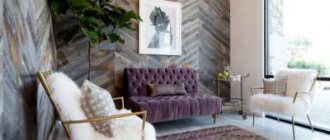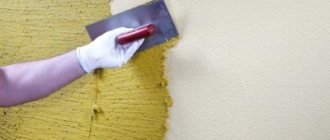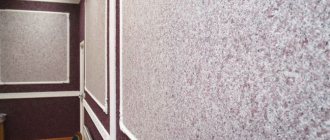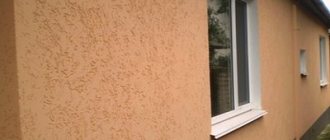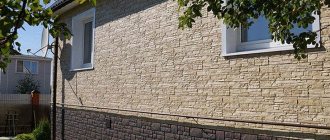Features of the material
Antique plaster is used to decorate the external and internal surfaces of walls.
The material is resistant to fire; when it dries, it forms a film on the surface that provides high performance characteristics of the coating and protects against mechanical impacts.
The plaster mixture is considered universal due to the components it contains that create the effect of cracking and abrasions. With its help, defective places on the walls are easily hidden and the room is given a “vintage” look.
Aging brick with plaster
You can achieve an original and impressive look for brickwork by applying a layer of wall plaster to it. You can use either a special (decorative) or the simplest one. It is necessary to choose colors that contrast with the main shade of the brick (light gray, beige, white), which will allow you to achieve the desired effect.
First, a plaster solution is prepared and then applied to the wall so that it appears as if a layer of plaster has peeled off due to time. The remaining bricks are aged with a blowtorch or sandpaper. The resulting texture of aged brick looks very impressive. During chaotic collapse of the plaster, this should be done carefully so that the entire coating does not collapse.
Advantages and disadvantages
The material has the following advantages:
- fits perfectly into the overall interior of any style;
- used when decorating the walls of dry rooms or in rooms with a high moisture content in the air;
- environmentally friendly raw materials are used in the preparation, the plaster does not cause allergenic reactions, it is recommended for finishing rooms for children;
- does not create any difficulties in maintenance, can be easily cleaned with detergents that do not contain solvents or abrasive additives;
- perfectly resists mechanical influences, natural phenomena and abrasion;
- Due to various fillings, it is used on surfaces made of chipboard, plasterboard, wood, fiberboard, concrete, brick, etc.
As a disadvantage, masters note the difficulties that arise when working with certain textures.
Venetian plaster for finishing
Venetian plaster has a soft transparency and radiant shine.
Venetian plaster, which has a special transparency and a soft, radiant shine, has recently become popular. It is made from marble flour, which creates the illusion of natural marble. In addition, the composition includes slaked lime and a special water emulsion.
Decorative plaster can only be applied to a perfectly flat surface; it can be tinted with paint of any color, depending on the effect you want to achieve. This plaster is waterproof, it is very durable, resistant to sudden temperature changes and sudden heating. One of the advantages it should be noted is that the composition dries quickly.
Venetian plaster is applied using the following technology:
- first the base of the wall is leveled, it must be perfectly even and smooth;
- after this, a special layer of primer is applied to the surface, intended only for working with Venetian plaster;
- the dried surface must be tinted in the chosen color in thin layers; after drying, the wall must be cleaned to eliminate all unevenness. There can be many such layers of paint - from 5 to 12. It all depends on the result you want to achieve;
- Using sandpaper in a circular motion, the surface is again cleaned, after which a layer of wax is carefully applied.
Return to contents
Where is it used?
When finishing interior walls, Venetian decorative plaster with an antique effect is most often used. It consists of various components that allow you to recreate a variety of textures and effects:
- durable marble stone of natural origin;
- luxurious shine like mother-of-pearl, gold and silver;
- cracked walls;
- internal section, etc.
The unusual performance indicators of the decorative plaster composition explain its demand for decoration:
- some elements in the interior, made in different design solutions - columns, fireplaces, niches and cornices;
- bathrooms, kitchens, sanitary units - the plaster solution provides reliable vapor permeability, resists exposure to a humid environment, and can be easily washed with a damp cloth;
- bedrooms and living rooms, rooms for children - mixtures consist of components of natural origin;
- buildings for commercial purposes - offices, hotel halls, restaurant halls, cafes, shopping and entertainment centers.
A room decorated with Venetian plaster retains its attractive appearance for a long time.
Types of decorative bricks
You can make aged decorative brick yourself, or you can purchase ready-made antique finishing material. It comes in several types: flexible, gypsum and clinker.
Clinker brick
Most closely resembles natural brick, it is a heat-resistant finishing material (made from clay at a temperature of 1200 degrees). Clinker brick imitates antiquity well, but is not cheap. Mainly used for lining existing stoves or fireplaces.
Gypsum brick
It has high moisture absorption, and therefore is suitable only for interior decoration. To reduce the level of moisture absorption, it is coated with varnish or waterproof paint. A very light, easy-to-work material that is not afraid of fire. Gypsum brick can be made even at home.
Flexible brick
Special decorative tiles used for cladding facades and decorating interior walls. Allows you to achieve the effect of neat brickwork. It is used not only on flat surfaces, but also on corner elements and rounded structures with non-standard design solutions. It has a pronounced texture, is stylized to resemble real brick and comes in all sorts of shades. The basis of raw materials is mineral-polymer components.
Tools and materials
Aged plaster is applied in various ways, so the work requires not only standard, but also special tools and devices.
The list of everything needed is as follows:
- spatulas of different widths with which the solution is applied;
- trowel and trowels - they are used to level the applied layer;
- a plumb line with which the surface is leveled vertically;
- Master OK;
- graters;
- textured rollers, soft-elastic stamps, sponges - they are used to apply relief patterns;
- containers made of plastic or stainless metal for preparing the plaster mixture;
- electric drill with mixing attachment.
If you plan to do plastering work on an ongoing basis, it is recommended to purchase relief rollers that have a durable coating made of Teflon or polyester material. For a one-time job done with your own hands, an inexpensive polyethylene tool will be enough.
When purchasing sponges for rubbing, keep in mind that for an elite finish, the natural marine version is best suited. True, such a sponge is quite expensive, so they often use a two-layer analogue for washing dishes instead. The rough finish is applied with the hard side, the finishing side is applied with the reverse side made of soft foam rubber.
Structural and textured plaster for finishing
Structural plaster is a specially prepared granular coating. Granules and various wood fibers are usually added to the mass; small pebbles can also be seen there. The base for plaster is synthetic latex, a mineral mass of lime and cement, and potassium silicate. A distinctive feature is that the mass is very plastic, obedient, and easy to apply.
After finishing, the surface of the plastered wall looks attractive; the granules contained in it form a beautiful pattern in the form of inclusions.
Textured compositions allow you to imitate various surfaces, for example, natural wood, chopped and hewn stone, crumpled paper. This plaster is perfect for any interior; you can choose different application techniques to create an unusual and original coating. The main component of the composition is lime flour, and special properties of textured plaster are given by fillers - these are marble and granite chips, polymers, natural fibers and mineral particles.
Return to contents
How to apply?
The effect of antiquity is achieved with “Crackelur” plaster mortar. Acrylic-based paint is applied to the wall, treated with a primer, and stretched with a roller in an even layer. After four to six hours, craquelure varnish is applied using a brush or roller.
Note that the direction of tool movement in the future determines the location of the cracks. It is allowed to work with a roller vertically or horizontally, or in different directions in turn.
The thickness of the varnish layer determines the depth of the cracks that form during the drying process of the surface, which requires time from forty to one hundred and twenty minutes. After final drying, apply Venetian or structural plaster with a spatula with a wide blade in a layer of no more than two millimeters, performing multidirectional movements. Instead of plaster, it is allowed to apply acrylic-based paint, making a layer of no more than 1 mm. The paint dries faster, cracks appear after just five minutes, and its application requires skill and speed. It is better to work in a vertical direction, without leaving smudges at the joining areas. The surface finally dries out after a day. With different types of mixtures, follow a certain algorithm of work:
- Antico paretto is a transparent mixture containing components of mineral origin, which are crushed at the time of application. The composition is stirred and applied in cross-shaped movements with a flat brush or short strokes. After treating a small area, it should be smoothed using a plastic putty. Movements can be multidirectional; it is advisable to distribute inclusions evenly over the surface;
- antique structural plaster compositions - the desired effect is achieved by forming a textured surface of the applied layer of plaster with fibers. The mixture is applied with trowels, its layer should not exceed three millimeters, after which the texture begins to form. The work is performed with the surface of the trowel close to the end part. Applying a small amount of mortar to the working surface with a spatula, press the trowel to the surface and slightly lift the plaster layer, preventing it from coming off. The mortar mass will be pulled behind the tool; it is formed with a trowel, performing arc-shaped movements in different directions. Thanks to the fibers of the mixture, the mass is pulled out into bizarre shapes behind the trowel. After about thirty minutes, when the surface has “set”, it is smoothed with a trowel. Sharp, rough areas are removed with sandpaper after complete drying, and the dust is swept away with a brush.
Various methods of aging brick
There are several ways to achieve an effect in which aged brick looks natural. All of them pursue one goal - to obtain an uneven, chaotically processed surface of the brickwork.
Mechanical aging.
An old wall inevitably acquires various defects: chips, cracks, abrasions, and the color becomes uneven. Therefore, to obtain this option for interior design made of brick, the masonry will have to be properly damaged. You need to prepare: a hammer and chisel, a hammer drill, a grinder with an abrasive disc or a grinder, a blowtorch.
Aging of color.
For this method of aging the surface, it is better to use gray or white acrylic paint, as well as a foam sponge or roller. A sponge is better because it allows you to apply the paint more randomly. Avoid drips and ensure that enough of the compound gets onto the seams. If you paint with a roller, do not saturate it completely, let it always remain semi-dry. Before the paint dries completely, its excess is removed from the masonry with a damp sponge. To imitate a surface covered with old moss, you can use dark green or gray-green paint. The mark must be made barely visible, so the dye is applied using the same sponge.
Imitation of old plaster.
You will need a spatula and light-colored plaster (white, beige or gray). The solution is applied in spots, the resulting layer should be uneven. In places where it thickens, after drying, you will need to go through it with a grinder, hammer or chisel, and the thin layer must be lightly rubbed until it becomes translucent. This method of aging brick will produce a rough, heterogeneous texture.
Antique wall painting
Antique-looking walls are painted using circular movements of the brush.
Now you can move on to painting the wall in an antique style. As is clear, there is no need to particularly prepare the surface for applying paint. Here you can only get by with a primer. No plaster or putty is used. The paint should be chosen so that it contains artificial latex. It is specially created for application to walls. At the same time, it has increased color fastness. The brush that will be used to paint the surface should have long bristles.
You need to paint not with simple movements from top to bottom, but in circular motions. In this case, be sure to apply pressure on the tool from time to time. In the place where pressure is applied, abrasions will form. This effect will give the surface an antique look. In fact, there is nothing complicated in the process of painting antique walls. The most important thing is to choose the right paint and brush, with the help of which all manipulations will be carried out. Pressing will prepare the surface for subsequent processing. After all, it’s not enough to just paint the wall, you also need to properly rub it down.
A brush is used for these purposes. With its help, the walls are rubbed. However, you can use other available means. For example, a sponge or sandpaper with fine grains of sand. They will also do an excellent job. The pattern of the antiquity on the wall depends on what movements are made with the brush. You can experiment here. There's nothing wrong with that.
Now the surface needs to be given a little time so that all the paint is completely dry. After this, technical wall wax is applied to it using a sponge. It is applied gradually, so each dried layer is first wiped with a soft cloth or rags. This work is quite painstaking, but after about 6 hours you will be able to see the fruits of your labor on the wall. It is important that the wall remains open when drying.
The room must be maintained at room temperature.
This will make the surface truly ideal without various types of defects.
The result is a beautiful shiny wall, on which the imprints of antiquity will be visible. This drawing can also be supplemented by the fact that antique furniture will be restored. This technique, combined with painting the walls, will be an excellent decoration for any apartment. Furniture is decorated using a slightly different method. Of course, the surface must first be cleaned. This is done using sandpaper. All layers of old paint, varnish and drying oil must be erased. After this, further surface treatment begins. But we can talk about this another time. Today we were talking about painting the walls in an antique style. As everyone was able to notice, there is nothing complicated in this matter. The most important thing is to do everything strictly in accordance with the instructions. It was given above.
One of the options for finishing wall surfaces is decorative plaster. It creates not only a reliable surface that perfectly protects against many types of influences, but also gives the interior and facade an unusual and stylish appearance. Do-it-yourself decorative plaster is applied using different techniques. The choice of composition determines what appearance the surface will acquire after finishing work. Plaster can imitate natural wood, metal, fabric, and create an unusual, but very fashionable today “antique” effect. The work itself is complex and requires some experience to complete it.
